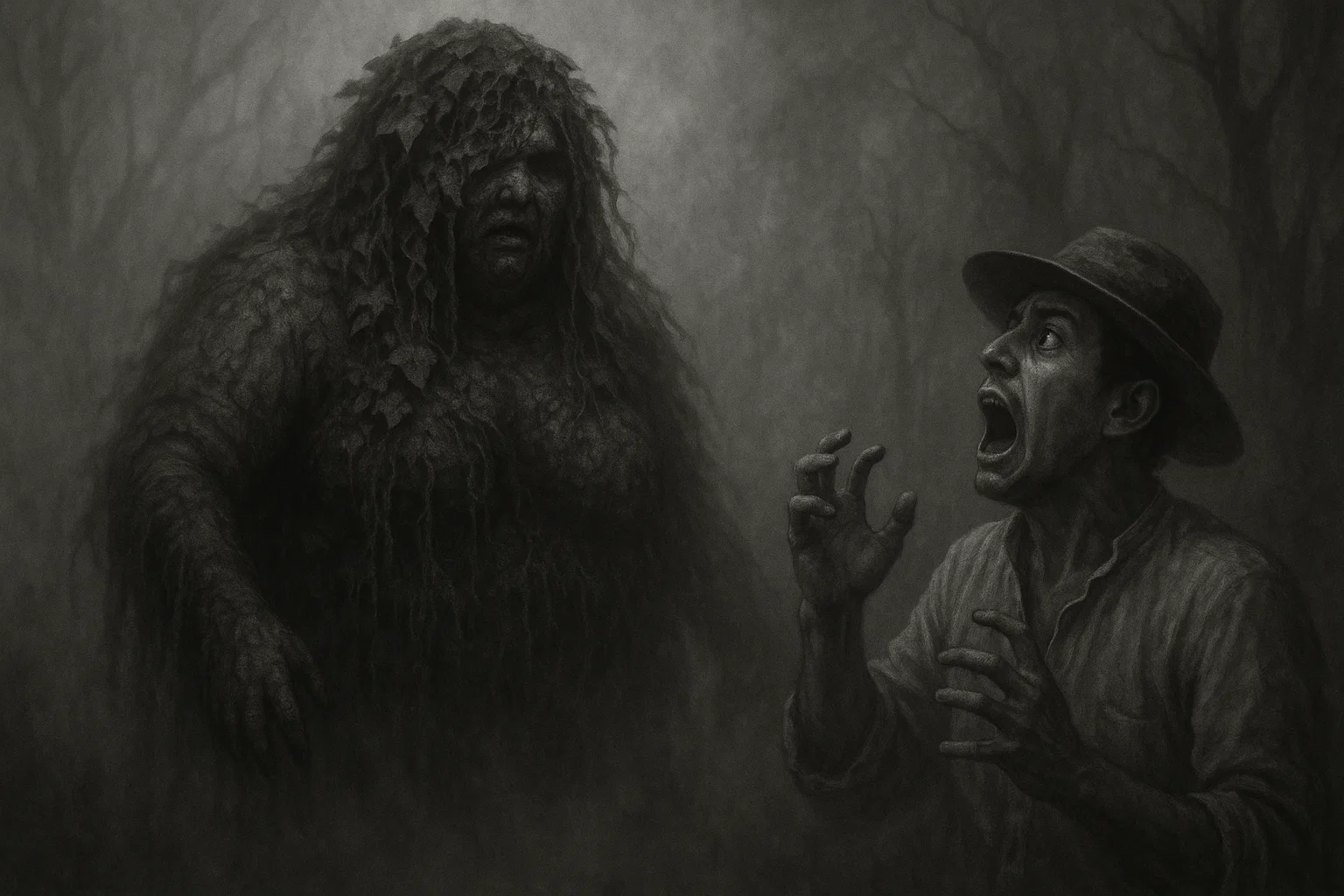Deep in the heart of Colombia’s lush forests, where ancient trees stand sentinel and rivers carve paths through the wilderness, whispers tell of a being both feared and revered: Madremonte, the Mother of the Mountain.
Known as a guardian of nature, this legendary cryptid is said to protect the environment with fierce determination, punishing those who dare to harm it.
Is Madremonte a creature of flesh and blood, a spirit born from folklore, or a powerful symbol of humanity’s connection to the earth? This article delves into the rich tapestry of her legend, exploring her origins, appearance, habitat, sightings, scientific perspectives, and comparisons with other cryptids.
Summary
What Is Madremonte?
Madremonte, translating to “Mother of the Mountain” or “Mother of the Forest,” is a central figure in Colombian folklore, embodying nature’s wrath and guardianship.
She is depicted as a powerful spirit who safeguards the wilderness, punishing those who engage in deforestation, pollution, or other environmental harm. Her legend serves as a cultural reminder to live in harmony with nature, reflecting deep-rooted values of environmental respect.
The name “Madremonte” combines the Spanish words “madre” (mother) and “monte” (mountain or forest), highlighting her maternal role over the natural world.
Her origins trace back to a fusion of indigenous beliefs, particularly those of the Muisca and Chibcha peoples, who revered deities tied to earth and water, and Spanish Catholic influences from the 16th-century colonial era, which introduced themes of sin and retribution.
This blend of cultural influences has shaped Madremonte into a multifaceted figure, representing both ecological and moral justice.
Beyond her role as a protector of nature, Madremonte is also seen as a figure of social justice, punishing individuals who commit moral wrongs, such as unfaithful spouses, thieves, or those who disrespect community norms.
This dual role makes her a complex character in Colombian folklore, intertwining ecological concerns with societal values. Her stories are often told around campfires or during family gatherings, serving as both entertainment and moral education.
Children are cautioned against venturing too deep into the forest, lest they encounter Madremonte, while adults use her tales to advocate for environmental protection.
In modern times, Madremonte has transcended folklore to become a symbol of environmental justice, appearing in literature, music, and art.
For instance, in the book Cuentos de la Madremonte by Guadalupe Urbina, she is portrayed as a metaphor for the consequences of environmental degradation, blending traditional folklore with contemporary issues.
Her image is also featured in environmental campaigns, where activists invoke her name to rally support for conservation efforts, tapping into her cultural resonance to promote sustainability.
Madremonte is also associated with specific rituals and superstitions. To appease her or avoid her wrath, locals may perform collective rituals during the rainy season, involving music, dance, and offerings of fruits, flowers, or maize.
What Does Madremonte Look Like?
Madremonte’s appearance is as varied as the regions that tell her story, adding to her enigmatic allure. Her physical description reflects the diverse landscapes and cultural influences of Colombia, making her a chameleon-like figure who embodies the essence of the forest itself.
In Antioquia, she is often described as a corpulent woman cloaked in leaves, moss, and vines, her skin resembling rough bark and her hair flowing like ivy. Her face is partially obscured by foliage, giving her an otherworldly appearance that blends seamlessly with the forest environment.
This depiction aligns with the dense, humid jungles of the region, where moss and vines are abundant, suggesting that her appearance is a direct reflection of her habitat.
In Tolima and Caldas, Madremonte may appear as a beautiful young woman with emerald eyes and hair like cascading waterfalls, embodying the seductive beauty of nature. This portrayal emphasizes the lush, fertile landscapes of these areas, where rivers and streams are central to the ecosystem.
You May Also Like: Is the Cahaba River Monster Real? Sightings, Theories, and Legend
Her beauty is said to lure wrongdoers deeper into the forest, only for them to become lost or punished, highlighting her dual nature as both enchanting and dangerous.
In other regions, she takes on a monstrous form, with elongated limbs, claw-like fingers, and glowing ember eyes that pierce through the darkness. Some accounts describe her as adorned with a leafy hat or features mimicking animals, such as the piercing gaze of a jaguar, the hiss of a serpent, or the antlers of a stag.
Her shape-shifting ability is a hallmark of her legend, allowing her to blend into her surroundings or adopt forms that inspire fear or awe. She can become part of the forest itself, merging with trees or dissolving into mist, making her nearly impossible to detect until she chooses to reveal herself.
Madremonte is also known for mimicking animal sounds, such as the cry of a jaguar, the rustle of leaves, or the chirps of crickets, using these calls to lure intruders deeper into the forest or scare them away from sacred sites.
Her clothing, composed of leaves, moss, and vines, is said to be ever-changing, reflecting the seasons and the state of the forest. During the dry season, she may appear withered, with brittle leaves and sparse foliage, symbolizing the forest’s vulnerability.
In contrast, during the rainy season, she is lush and vibrant, with verdant greenery that pulses with life. Some accounts describe her as having the power to control plants, causing vines to entangle wrongdoers or trees to shift to block paths, further emphasizing her dominion over the natural world.
This adaptability to her environment suggests that Madremonte is not out of place but rather an intrinsic part of the ecosystem. Her appearance is a manifestation of the forest’s health and vitality, making her a living embodiment of the natural world.
Unlike cryptids that seem alien to their surroundings, such as the Loch Ness Monster in its aquatic habitat, Madremonte’s form is perfectly suited to the dense, biodiverse jungles and mountains of Colombia, reinforcing her role as the forest’s collective will.
Where Does Madremonte Live?
Madremonte is believed to inhabit the dense jungles and mountainous regions of Colombia, particularly in the Colombian Andes, including areas like Antioquia, Caldas, Tolima, and the valleys of Magdalena and Cauca. These regions are renowned for their rich biodiversity, hosting a vast array of flora and fauna, which makes them fitting domains for a nature spirit like Madremonte.
Her legend also extends to parts of Ecuador, Argentina, Brazil, and Paraguay, where she is known by names such as Madreselva (Honeysuckle) in Brazil, Fantasma del Monte (Ghost of the Mount) in Argentina, or Madre de los Cerros (Mother of the Hills) in Paraguay, reflecting the shared cultural reverence for nature across South America.
The terrain associated with Madremonte is characterized by lush vegetation, steep mountains, and remote forests, often inaccessible to humans. These environments are pristine yet vulnerable to human activities like logging, mining, and agriculture, which are said to provoke her wrath.
The Colombian Andes, for instance, feature old-growth forests with trees hundreds of years old, creating a mystical atmosphere that enhances her legend. Rivers and streams are also significant, as they are believed to be her bathing places, and their waters are considered sacred.
When angered, Madremonte is said to bathe in these waters, causing them to become turbid and overflow, leading to floods and destruction. This connection to water ties her to the natural cycles of the environment, reinforcing her role as a guardian of ecological balance.
The areas where Madremonte is said to live are steeped in paranormal and mythological significance. The Colombian Andes have a history of indigenous settlements, particularly by the Muisca and Chibcha peoples, who revered nature deities and believed in spirits that protected sacred sites.
You May Also Like: Ariton (Egin): The Demon Who Knows Your Past, Present, and Future
These beliefs likely influenced the development of Madremonte’s legend, as a response to environmental and cultural changes brought by Spanish colonization in the 16th century. The regions are also associated with other local legends and cryptids, such as the Mohán, a river spirit who lures women with his music, or the Tigre Dantero, a striped jaguar-like creature.
Historically, the Colombian Andes have been sites of unexplained phenomena, including reports of strange lights, disembodied voices, and sudden weather changes, which locals often attribute to Madremonte or other spirits.
During the colonial era, tales of disappearances in the forests were common, particularly among loggers or settlers who encroached on indigenous lands, further fueling her legend. These events, combined with the region’s rugged terrain and dense vegetation, create an ideal setting for stories of a nature protector who punishes those who disrespect the land.
The biodiversity of these areas also plays a role in Madremonte’s legend. The Colombian Andes are home to unique species, such as the Andean condor, spectacled bear, and countless plant species, many of which are found nowhere else on Earth.
Madremonte Sightings
| Date | Location | Details |
|---|---|---|
| Unknown (Pre-20th Century) | Colombian Andes, rural areas | Indigenous tales describe Madremonte as a forest guardian punishing those who harm nature. No specific dates recorded. |
| 1920s | Caldas, Colombia | Local farmers reported seeing a tall, moss-covered woman near rivers, scaring trespassers. Details vague, passed orally. |
| 1948 | Antioquia, Colombia | A hunter claimed Madremonte appeared as a spectral figure covered in leaves, emitting wails after he cut down trees. |
| 1973 | Boyacá, Colombia | Villagers reported a shadowy female figure in the forest, linked to sudden storms after illegal logging. No physical evidence. |
| 1995 | Cauca Valley, Colombia | A group of campers described a tall, green-skinned entity with vine-like hair watching them, disappearing into the woods. |
| 2010 | Santander, Colombia | A farmer alleged Madremonte chased him from a forest after he littered, describing her as a towering figure with glowing eyes. |
Madremonte’s existence is primarily documented through folklore rather than verifiable sightings, making her a figure of legend more than empirical evidence. Her stories are deeply embedded in Colombian oral traditions, passed down through generations and often tied to specific events or moral lessons.
Despite the lack of concrete evidence, these tales remain vivid and compelling, reinforcing her role as a nature protector and a cautionary figure against environmental harm.
One of the most well-known stories involves a logging crew in Antioquia that ignored warnings from local elders and felled sacred trees in a protected forest. The crew vanished without a trace, and search parties reported encountering eerie fog, whispers in the wind, and a shadowy figure resembling a corpulent woman draped in leaves with glowing eyes.
The incident, though undated, is frequently cited in folklore as evidence of Madremonte’s wrath, with locals attributing the disappearance to her punishment for desecrating the forest.
In Tolima and Caldas, locals claim to hear blood-curdling screams during stormy nights, often near dense bushes or jungle-like areas. These screams are said to be Madremonte’s cries of anger, triggered by environmental harm such as illegal logging or pollution.
Severe weather events, such as storms and floods, are frequently attributed to her displeasure, particularly when rivers become turbid and overflow. For example, farmers in Caldas have reported strange fog and whispers in the forest during the 20th century, which they believed were signs of Madremonte’s presence, warning them to respect the land.
You May Also Like: Smile for the Dead Girl | Horror Story
Another tale recounts a group of hunters in the Magdalena Valley who ventured deep into the forest in pursuit of game. They heard unearthly screams and found their path blocked by suddenly appearing thickets, forcing them to abandon their hunt.
The hunters later claimed to have seen a tall figure covered in vines watching them from the trees, which they identified as Madremonte. Similarly, a story from Cauca tells of a man who cut down a sacred ceiba tree and was found dead the next day, with no apparent cause of death. Locals attributed his demise to Madremonte’s curse, believing she had exacted justice for his transgression.
In modern times, online forums and social media platforms, such as X, have seen occasional reports of Madremonte encounters. Anonymous users claim to have heard wails or seen shadowy figures in remote forests, particularly in areas known for environmental degradation.
For instance, an X post from 2023 described a hiker in Antioquia who heard eerie cries during a storm and felt an overwhelming sense of being watched, attributing the experience to Madremonte.
However, these accounts lack verifiable details, such as specific dates, locations, or corroborating evidence, and are often dismissed as hoaxes or misinterpretations of natural phenomena.
Is there Any Evidence?
Despite the richness of these stories, no physical evidence—such as photographs, videos, footprints, or other tangible proof—has been documented to support Madremonte’s existence.
Unlike cryptids like Bigfoot, which has the famous Patterson-Gimlin film, or the Loch Ness Monster, with its blurry photographs, Madremonte’s legend relies entirely on anecdotal evidence.
No newspaper articles, magazine reports, or official documents from authorities have recorded specific sightings or investigations into Madremonte.
Cryptozoologists have not conducted formal studies of her, likely due to the remote and inaccessible nature of her supposed habitat and the absence of physical traces to pursue.
The lack of evidence aligns with the broader pattern of cryptid lore, where stories thrive on cultural significance rather than empirical proof. Madremonte’s legend persists through oral traditions, cultural festivals, and modern retellings, such as performances at the Festival of Legends in Valledupar, where actors portray her in elaborate costumes, bringing her stories to life.
Scientific Perspective
From a scientific perspective, Madremonte is classified within the realm of cryptozoology, the study of creatures whose existence is disputed or unsubstantiated by mainstream science.
Cryptozoology is widely regarded as a pseudoscience due to its reliance on anecdotal evidence and lack of adherence to the scientific method. While biologists regularly discover new species through rigorous methodologies, cryptids like Madremonte are often rooted in folklore and rumor, making their verification challenging. The absence of physical evidence, such as fossils, bones, or DNA, further undermines claims of her existence as a real creature.
No scientific evidence supports Madremonte’s existence as a physical entity. Her stories are likely cultural constructs, possibly arising from misinterpretations of natural phenomena.
For instance, the wailing sounds attributed to her may be caused by wind passing through trees, a common occurrence in forested areas that can produce human-like cries. This phenomenon is similar to the origins of the banshee in Irish folklore, where wind sounds were mistaken for supernatural wails.
You May Also Like: Maple Hill Cemetery Haunting: Ghost Child Sightings and Eerie Legends
Sightings of shadowy figures could result from misidentifications of animals, such as jaguars or large birds, or optical illusions in dense jungles, where low light and thick vegetation create ambiguous shapes.
Another possible explanation is pareidolia, a psychological phenomenon where people see patterns, such as faces or figures, in random or ambiguous images.
In the context of Madremonte, locals might interpret natural formations, like moss-covered rocks or tangled vines, as a humanoid figure, especially in the context of folklore that primes them to expect her presence. This theory is supported by the lack of consistent descriptions of her appearance, which vary widely across regions and accounts.
From a cultural anthropology perspective, Madremonte’s legend likely represents a collective memory of pre-Columbian deities or spirits that were assimilated into colonial folklore.
The Muisca and Chibcha peoples revered nature deities, such as Bachué, the mother goddess associated with water and fertility, who shares similarities with Madremonte’s protective role.
During the Spanish colonization, these indigenous beliefs were blended with Catholic notions of sin and retribution, creating a hybrid figure that reflects both cultural traditions. This cultural projection explains why Madremonte punishes not only environmental harm but also moral wrongs, such as infidelity or theft, aligning with colonial moral frameworks.
Environmental symbolism is another key explanation for Madremonte’s legend. Her stories function as cautionary tales, discouraging deforestation, pollution, and other forms of environmental harm by instilling fear of supernatural punishment.
This role is particularly relevant in Colombia, where biodiversity is threatened by logging, mining, and agriculture. By personifying the forest’s wrath, Madremonte serves as a cultural mechanism to promote conservation and respect for nature, even in the absence of scientific evidence for her existence.
Despite her lack of scientific credibility, Madremonte’s cultural significance is undeniable. She appears in environmental campaigns, murals in cities like Bogotá and Medellín, and events like the Festival of Legends in Valledupar, where she is celebrated as a symbol of sustainability.
Her legend has also inspired modern activism, with environmental groups using her image to raise awareness about climate change and deforestation.
From a scientific perspective, while Madremonte may not be a real creature, her role in shaping environmental ethics highlights the power of folklore in influencing human behavior and cultural values.
Potential Explanations
Several theories attempt to explain the Madremonte legend, each offering a rational perspective on her origins and significance:
- Misidentification of Natural Phenomena: Sounds like wails or screams may be attributed to wind, animals, or other environmental factors, misinterpreted as supernatural. For example, the sound of wind through trees or the calls of nocturnal animals, such as owls or howler monkeys, could be mistaken for Madremonte’s cries. Shadowy figures might be animals or natural formations seen in low-light conditions, amplified by cultural expectations of her presence.
- Cultural Projection: Madremonte’s stories likely blend indigenous reverence for nature spirits with colonial notions of punishment, creating a hybrid figure that reflects cultural values. Her origins may trace back to pre-Columbian deities, such as the Muisca goddess Bachué, combined with Catholic themes of sin and retribution, resulting in a figure who enforces both ecological and moral order.
- Environmental Symbolism: Her legend functions as a cautionary tale, discouraging environmental harm and promoting respect for nature, rather than describing a literal creature. By personifying the forest’s anger, Madremonte encourages conservation and sustainability, serving as a cultural tool to protect vulnerable ecosystems.
- Psychological Factors: Pareidolia and confirmation bias may lead people to interpret ambiguous sights or sounds as evidence of Madremonte, especially in communities where her legend is well-known. Fear of supernatural punishment could also reinforce belief in her, as people attribute unexplained events to her influence.
Comparison With Other Similar Cryptids
To contextualize Madremonte, it’s useful to compare her with other cryptids, particularly those associated with nature or protective roles:
| Cryptid | Region/Environment | Physical Appearance | Behavior | Similarities to Madremonte |
|---|---|---|---|---|
| Yacumama | Amazon Basin, rivers | Giant serpent, sometimes humanoid female | Guards waterways, causes floods | Water association, nature guardian |
| La Llorona | Latin America, near rivers | Weeping ghostly woman, white dress | Haunts rivers, seeks children | Female entity, river proximity, spectral |
| Pombero | Paraguay/Argentina, forests | Small, hairy humanoid, dark skin | Mischievous, protects forests | Forest guardian, punishes trespassers |
| Curupira | Brazil, Amazon forests | Small, red-haired, backward feet | Protects forest, misleads hunters | Forest protector, punishes environmental harm |
| Chullachaqui | Peru/Brazil, Amazon jungle | Small, shapeshifting humanoid | Tricks intruders, guards jungle | Forest guardian, deceptive behavior |
| Sasquatch | North America, forests | Large, hairy, ape-like | Elusive, avoids humans | Forest dweller, elusive nature |
| Yeti | Himalayas, mountainous forests | Large, hairy, ape-like | Elusive, territorial | Forest/mountain habitat, mysterious |
| Banshee | Ireland, near forests/fields | Wailing female spirit, pale, long hair | Foretells death, haunts specific areas | Female, spectral, tied to specific locales |
| Leshy | Slavic regions, forests | Tall, green-skinned, plant-like male | Protects forest, misleads travelers | Nature guardian, plant-like appearance |
| Wendigo | North America, forests | Gaunt, monstrous humanoid, antlers | Malevolent, cannibalistic | Forest dweller, punishes human transgressions |
| Nix | Scandinavia, rivers/lakes | Shapeshifting, often female, water-bound | Lures victims to water, protects rivers | Water association, female entity |
| Kikimora | Slavic regions, forests/swamps | Female spirit, sometimes hag-like | Mischievous, tied to natural areas | Female, nature-linked, elusive |
| Tunda | Colombia, Pacific coast forests | Shapeshifting female, monstrous leg | Lures men, traps them in forests | Colombian forest entity, female, deceptive |
Madremonte stands out for her shape-shifting abilities and explicit role as a nature protector, aligning closely with cryptids like Mapinguari and Yacumama, which also guard natural environments. Unlike Bigfoot or Mothman, which are more elusive or ominous, Madremonte’s legend is deeply tied to human morality and environmental ethics, making her a unique figure in cryptozoology.
Is Madremonte Real?
The question of Madremonte’s reality is complex, as it intertwines empirical evidence with cultural significance. Scientifically, there is no proof of her existence as a physical being, and her stories are likely rooted in folklore, natural phenomena, or cultural projections (Wikipedia – Cryptozoology).
However, her legend is undeniably real in its impact, serving as a powerful symbol of environmental conservation and respect for nature. In Colombia, Madremonte’s image appears in art, festivals, and environmental campaigns, reinforcing her role as a guardian of the earth.
As humanity grapples with environmental challenges, Madremonte’s story resonates as a call to protect the planet. Whether she exists in the forests or in the collective imagination, her legacy endures, inspiring generations to cherish and preserve the natural world.
In this sense, Madremonte is as real as the values she represents, living on in the hearts of those who advocate for a sustainable future.







